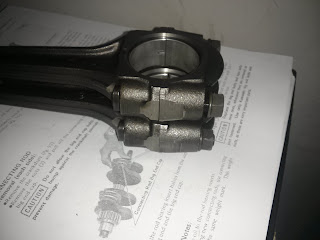
One month before I started this restoration bobber project, I knew next to nothing about motorcycles (or engines for that matter). Camshaft? No clue. Petcock? Sorry. But I did know that the piston goes up & down so that at least was something. I also knew this: No matter how long this takes, I will one day ride a kickass custom hand-built kz750 hardtail bobber.
Sunday, July 21, 2013
Connecting the Connecting Rods
Balancer Assembly
Thursday, July 18, 2013
Replacing Parts Part II
These are the "new" balancer chain slippers ordered off ebay which also are in better shape.
I forgot to post some before and after engine cleaning pictures before I took the long break from this project so here you go! It was a combination of old fashion elbow grease and glass bead blasting. My homemade blasting cabinet was a little too small so I did some of it in my back yard. After glass beading, I went nuts with a pressure washer to clean out the beads. You don't want that stuff inside your engine. When pressure washing, some small parts like washers and o-rings started flying out from who knows where. Luckily, I retrieved them all and have now figured out where they came from. She cleaned up pretty good, no?
Wednesday, July 17, 2013
Next Project?
Viragos are ugly. But this is one of the best cafe racers I've ever seen. I'm not a big fan of cafe racers either, yet I LOVE THIS BIKE!
What an amazing transformation. Its old school but also has a futuristic look to it. Just beautiful.
My next poject is a long way off, but this is near the top. Viragos can be had cheap too.
Replacing Parts
Sunday, July 7, 2013
Everything Now in Reverse.
So finally I'm getting to the rebuild in the phrase "engine rebuild". Everything before was teardown, dismantle, take apart and unscrew. The first two are quick shots of the bare lower crankcase and a gear shaft. The first step was to just look at all the case parts and get reacquainted with them. They sat in baggies so long I forgot what was what. After a few days of looking at the parts diagrams and laying it all out on my workbench, I felt confident enough to start actually placing parts back into the crankcase.
The 3rd pic is the first part to actually be reassembled! The shift drum I believe. With this I learned a valuable lesson. Follow those parts diagrams with extreme precision. I noticed right away that a circlip was missing. But not until a few days later did I realize almost by chance that another part was missing from the shift drum assembly- a little 4mm x 6mm dowel pin. Yikes. How many more little parts like that can I miss? Anyhow, those are now on order.
The shop manual is a mess, in my opinion. The reassembly steps are spread out all over. There is not a separate section devoted it. Instead, its tacked on at the end of each part's dismantling instructions. It creates constant flipping back and forth with no clear start or end point.
The last pic is a complete gasket set from Vesrah orded off ebay. I've read these are better quality than Athena.






































